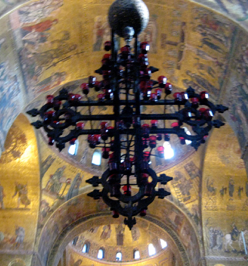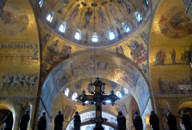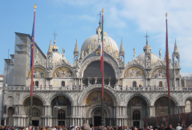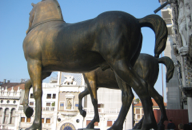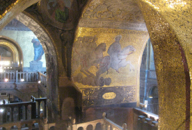BASILICA SAN MARCO
PIAZZA SAn marco
venice, italy
Europe
October 20, 2008


BASILICA SAN MARCO
PIAZZA SAn marco
venice, italy
Europe
October 20, 2008




The Basilica of San Marco is the most famous church in Venice and is one of the best known examples of Byzantine architecture. It is the third church to stand on this ground, the first built in 832 to house the relics of St. Mark, stolen by the Venetians from Alexandria, Egypt. This structure was destroyed by fire, and its replacement was demolished to build the current edifice, richly embellished with mosaics of gold, built between 1063-94, The plan of San Marco, based on Justinian’s Basilica of the Apostles in Constantinople, is in the form of a Byzantine cross with five domes, one in the center. Each of the four arms of the cross has a nave with a dome of its own. The Ascension dome in the center of the basilica contains 13th century mosaics depicting Christ surrounded by angels, the Virgin Mary, and his twelve apostles. The Pentecost Dome, nearest the central doorway, depicts the Decent of the Holy Ghost as a dove. Fourteenth century mosaics embellish the dome of the Baptistry, depicting Herod’s Banquet and scenes from the life of St. John the Baptist. Henry and I saw each of these domes and more, as we toured the basilica on our first full day in Venice. We chose to begin our tour upstairs with the loggia outside, overlooking Piazza San Marco, then tour the museum on the same level before descending to walk through the interior space of the basilica itself. Outside, we stood amongst the replicas of the Horses of St. Mark on the balcony, then saw the originals from Constantinople inside in the museum. Story boards with multi-lingual explanations revealed the history of the building, while excellent lighting and walkways allowed us a more intimate observation of the mosaics in the domes. We also bought a ticket to tour the area behind the altar to view the Ciborium, or canopy, with its scenes of the New Testament. On the back side of the altarpiece is the Pala d’Oro, a 10th century work of art fabricated by goldsmiths. It contains 250 gold panels embellished with enamel, and adorned with precious stones. A few of these stones were taken as booty by Napoleon when he conquered Venice in 1797. Basilica San Marco is such an important architectural site, that both Henry and I were eager to see it again. In the early 1980’s, Henry was guided on a private tour which explained the processional and theorized the symbolism and iconography of the church. In the late 1970’s, I was part of a university tour led by an art historian who specialized in art and architecture of the Renaissance. This small group also attended an evening concert held in Basilica San Marco. Honoring this event, the basilica’s interior was decorated with roses on the balustrade, while musicians performed in white tie amidst candlelight glittering off the gold mosaics, all further enhancing the classical music and creating a memorable experience. To distinguish this visit together, Henry and I decided to see the church “in action” by attending a solemn high mass on our last day in Venice. It gave us a chance to fully understand the significance of the architecture, to enjoy the beauty of the environment, and to hear the music and the resonance of the choir and the spoken word within the exquisite space of Basilica San Marco. Sunday morning we sat on folding canvas chairs, placed in rows on a pavement of complex 11th century mosaic floors, which were fabricated in opus sectile and opus tesselatum techniques. These now wavy floors have become rippled over the centuries with the settling of the foundations. Most of the pavement mosaics in the basilica contained geometric designs; however, some of these floors contained depictions of peacocks, foxes, and hens, a lively menagerie of symbolism. Attending mass here exposed us to this beautiful and solemn event, which gave us more understanding of the significance of the architecture, the symolism, and the basilica itself.
PHOTOS: Left Column: 1. Façade, Basilica San Marco. 2. Detail, central doorway with 17th century mosaics. 3. Interior view, gold mosaics. 4. 13th century mosaic depiction of King David and King Solomon. Center, Top: St. Mark and the angels crowning the central arch on the façade, c. 15th century. Center, Bottom: The Byzantine cross with candles suspended from the center of the basilica. Right Column: 1. Façade, Basilica San Marco, some of it under scaffolding. 2. View beneath the Horses of St. Mark looking toward the Procuratie Vecchi on the north side of Piazza San Marco. 3. Mosaic ceiling detail viewed from the 2nd floor. 4. Detail, 13th century mosaic depiction of St. Mark.

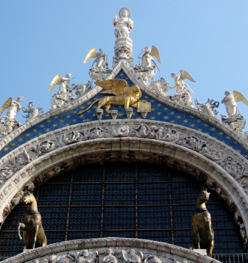
Byzantine Architecture
